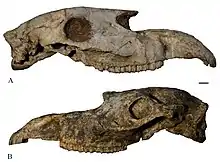| Proboscidipparion Temporal range: | |
|---|---|
 | |
| Skulls of Proboscidipparion pater | |
| Scientific classification | |
| Domain: | Eukaryota |
| Kingdom: | Animalia |
| Phylum: | Chordata |
| Class: | Mammalia |
| Order: | Perissodactyla |
| Family: | Equidae |
| Subfamily: | Equinae |
| Tribe: | †Hipparionini |
| Genus: | †Proboscidipparion Sefve, 1927 |
| Species | |
|
†P. heintzi | |
Proboscidipparion is an extinct genus of horse that lived in Eurasia during the Pliocene around 7.1 - 4 million years ago.[1] It is known for having a rather elongated skull, in which some speculate to have had a proboscis similar to a tapir.[2] Fossils have been found throughout Eurasia, from England to China.[3][4]
References
- ↑ Bernor, Raymond L.; Sen, Sevket (2017-06-01). "The Early Pliocene Plesiohipparion and Proboscidipparion (Equidae, Hipparionini) from Çalta, Turkey (Ruscinian Age, c. 4.0 Ma)". Geodiversitas. 39 (2): 285–314. doi:10.5252/g2017n2a7. ISSN 1280-9659. S2CID 134010870.
- ↑ "Proboscidipparion pater". prehistoric-fauna.com. Retrieved 2018-05-12.
- ↑ Sciences, Chinese Academy of. "Skull of Three-Toed Horse Found". ScienceAlert. Archived from the original on 2018-05-13. Retrieved 2018-05-12.
- ↑ Wang, Xiaoming (2013-05-14). Fossil Mammals of Asia: Neogene Biostratigraphy and Chronology. Columbia University Press. ISBN 9780231520829.
This article is issued from Wikipedia. The text is licensed under Creative Commons - Attribution - Sharealike. Additional terms may apply for the media files.